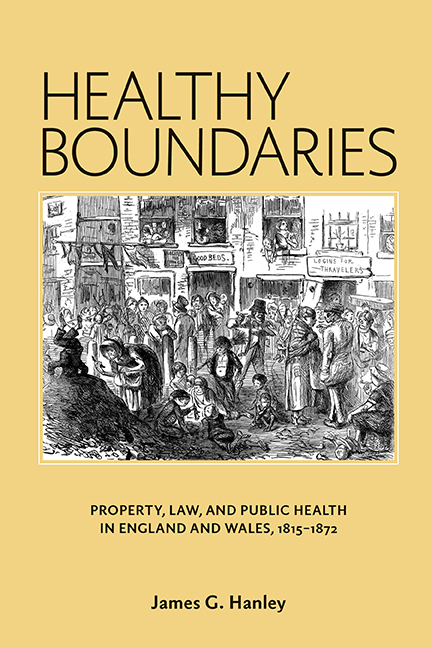Book contents
- Frontmatter
- Dedication
- Contents
- Acknowledgments
- Abbreviations
- Introduction
- 1 The Laws of Nuisance Before 1846: Property, Health, and Democracy in the Age of Reform
- 2 Private Benefit and Public Service: Paying for Sewers Before 1848
- 3 The Boundaries of Health, 1848–70
- 4 The Benefits of Health: London, 1848–65
- 5 Healthy Domesticity, 1848–72
- Conclusion
- Notes
- Bibliography
- Index
4 - The Benefits of Health: London, 1848–65
Published online by Cambridge University Press: 07 May 2022
- Frontmatter
- Dedication
- Contents
- Acknowledgments
- Abbreviations
- Introduction
- 1 The Laws of Nuisance Before 1846: Property, Health, and Democracy in the Age of Reform
- 2 Private Benefit and Public Service: Paying for Sewers Before 1848
- 3 The Boundaries of Health, 1848–70
- 4 The Benefits of Health: London, 1848–65
- 5 Healthy Domesticity, 1848–72
- Conclusion
- Notes
- Bibliography
- Index
Summary
In order to build healthy infrastructure, Epsom's local board of health had to persevere through two defeats at quarter sessions, a hostile parliamentary select committee, and a hearing at Queen's Bench. Similar efforts in London were even more difficult. Aspects of this struggle, including the immense engineering and technical difficulties, are well known, and I do not intend to revisit them. My focus here is on the struggle to pay for them. I do not mean the political struggle of getting elected bodies to vote taxes; I mean the prior and in some ways more fundamental struggle to obtain the legal power to levy rates for metropolitan purposes or even for purposes beyond those benefiting individual properties. In the course of the effort to establish this power, various levels of London's government faced mass civil disobedience, powerful corporate adversaries, hostile metropolitan and parliamentary opinion, and skeptical judges.
Part of the problem in London was that there was no “London” on a map, apart from the City, and no administrative entity with oversight over the whole of it. There was no agreement even about where it ended. In 1840 the largest border belonged to the Metropolitan Police District, supervised by the Home Office, which spread out roughly fifteen miles from Charing Cross. In 1851, the Registrar General developed the much more compact metropolitan census district, but it was a statistical, not an administrative, entity. Even the metropolitan census district comprised parts of three counties (Middlesex, Kent, and Surrey), the City of London, forty-two Poor Law authorities, and more than sixty parishes, precincts, liberties, and extraparochial places. Within each of these boundaries, a wide variety of what the Webbs called statutory authorities for special purposes carried out a host of activities. From the perspective of this book, the most important statutory authorities were the ancient separate commissioners of sewers, sprawling over an ill-defined but large area of potential jurisdiction. But they made up only a fraction of the total; as Briggs notes, two hundred fifty local acts of Parliament controlled ten thousand commissioners of one or another kind in London.
This profusion of authorities, often exercising overlapping functions, was only partially reformed by the Whigs in the 1830s.
- Type
- Chapter
- Information
- Healthy BoundariesProperty, Law, and Public Health in England and Wales, 1815–1872, pp. 89 - 110Publisher: Boydell & BrewerPrint publication year: 2016



